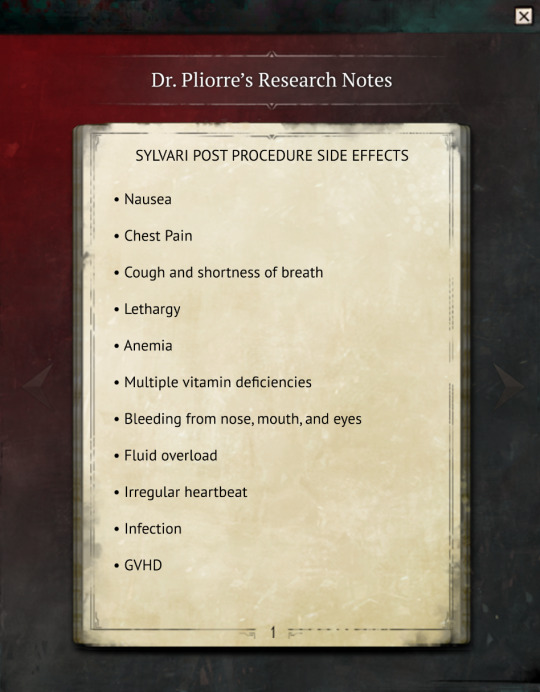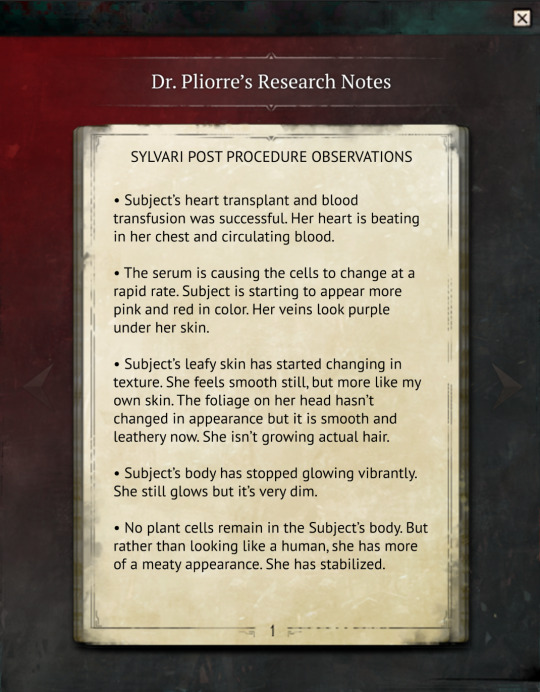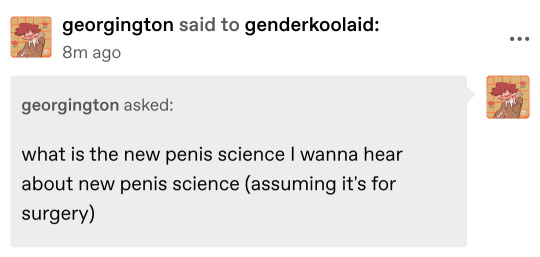#decellularization
Explore tagged Tumblr posts
Photo

"Ghost Heart" - The Art of Decellularization
48 notes
·
View notes
Text
Baby (18 year old) Riz stripping the cells from a pig heart with the STEM club funds and a modified version of the decellularization protocol found on the diy website instructables.com lmao


My first "research" project
Funny that I'm sentimental about tissue engineering and organ transplant research because of my pig heart decellularization project in my second semester of undergrad. Like. What a thing to go awww about. lmao.
8 notes
·
View notes
Text

Decellularization is the name for a tissue engineering technique which is designed to strip the cells from a donor organ, thus leaving nothing but connective tissue that once held the cells in place. It’s referred to as a “ghost organ” for it’s pale appearance. It can then be reseeded with the patient’s cells. The goal is to render an organ that can be transplanted into a patient without of the tissue being rejected.
1K notes
·
View notes
Text

This image shows a decellularized heart, stripped of all native cells, leaving behind an intact vascular system and a scaffold that has been infused with stem cells.
One of the greatest limitations to organ transplantation derives from organ rejection caused by antibodies of the transplant recipient reacting to donor antigens on cell surfaces within the donor organ.
By re-cellularizing an decellularized organ with a patient’s own cells, the adverse immune response is eliminated.
250 notes
·
View notes
Text

🥩Let's Not Meat🥩
Lore Part 1
Dr Pliorre's Traits: Envious, genius, loner, haughty, apathetic, not easily impressed, insusceptible, egotistical, dominating, deadpan most of the time, workaholic, observer, and realist.
Asura | Lesbian | 57 years old | 4'5" | Class: Thief She's not much of a kleptomaniac but she can defend herself/stealth when she needs to.
Saibh's Traits: Submissive, detached, follower, low self esteem (a little bit into humiliation), obedient, brave, humble, horny, not innocent, sad, smart, broken, quiet/reserved, introverted, malleable, and tired.
Pronounced "Sive" | Lesbian | 3 years old at capture | 5' tall | Class: Necromancer Her necromancy is very give and take. And powerful.
Dr Pliorre is an independent inquest biologist/zoologist who has her own lab and 2 assistants. Saibh is her current experiment/fixation.
Location of the lab:

Pliorre's Experiment 1
Dr Pliorre's experiment is like a combination of the meat berry experiment and The Ship of Theseus paradox. There's decellularization, injections of a serum that she developed that transforms plant cells, and a few surgeries/organ transplants from unwilling donors. I imagine she uses alchemy to force Saibh's body to accept these changes. She basically wants to see if she can change the anatomy of a sylvari to be like a human. The experiment is working, however Saibh starts turning more meaty/fleshy (like necromancer minions or kryptis) instead of gaining a human-like appearance.
After the procedures are complete, Pliorre gives Saibh time to heal. She takes samples from her every day to see the progress of the transformation. And she does daily check ups as well to make sure Saibh isn't dying.


#gw2#guild wars 2#guild wars 2 asura#gw2 asura#gw2 screenshot#gw2 character#dr pliorre#inquest asura#my oc#lets meat#dr pliorre and saibh#asura#sylvari#lackluster plays#Lets Not Meat#oc lore#Im hoping to do a few more parts for this#I need to make a post about their relationship dynamic >:3c#and then Saibh needs a backstory post#i just wanted to get the main bit out
20 notes
·
View notes
Text
Are you telling me scientists are becoming Jared Hopworth making flesh flowers
3 notes
·
View notes
Text
if decellularizing real human tissue to reseed it becomes a dominant tech before/instead of lab grown shit its gonna be so funny when we eventually get phalloplasties you hook up with a guy and youre like oh god thats my dead ex's cock. like its a different thing when its someones heart or whatever thats secret in there
3 notes
·
View notes
Text
Towards clinical application of tissue engineering for erectile penile regeneration | Nature Reviews Urology (paywalled)
Towards clinical application of tissue engineering for erectile penile regeneration (unpaywalled)
Complete Human Penile Scaffold for Composite Tissue Engineering: Organ Decellularization and Characterization | Scientific Reports (as linked above, no paywall, contains explicit images)
Complete Human Penile Scaffold for Composite Tissue Engineering: Organ Decellularization and Characterization | Scientific Reports (alternate, contains explicit images)
Engineered penis raises reproduction hopes | Nature (as linked above, paywalled)



@spacedembers @georgington
the people are hungry for penis knowledge and i must provide
so: y'all remember that post about them turning a grape into a meat grape? basically using the same process (de/recellularization), scientists are aiming to create transplantable penises w/o the concerns that come with organ transplants by removing the cells from a donor to get a scaffold, and replacing them with the receiver's cells, which would avoid concerns about rejection
here's the article I read on it; disclaimer that's it's a Very scientific read. I do not know much about science, but this process has seen success in rabbits who had their penises surgically removed; they were able to achieve full erections and impregnate female rabbits. I don't think trans humans will be able to ejaculate anytime soon, but if this becomes an accessible form of surgery it would mean we could have a form of phalloplasty that allows for natural erections!!! which is really really cool. obviously this is all far from available for us rn but it's very exciting to see this being researched, and it seems like we have good reason to be optimistic about the future!
also, the article specifically mentions trans surgery, which is really nice. a lot of articles about penis reconstruction/transplants I've seen only focus on the potential benefits for cis men, so i really appreciate that they bring up how this has the potential to revolutionize bottom surgery
2K notes
·
View notes
Text
This is a “ghost” heart—a heart that has been drained of blood and decellularized.

0 notes
Link
Decellularization involves stripping cells from donor tissue to leave behind the extracellular matrix and its chemical cues. That extracellular matrix can then be repopulated with patient-matched cells and transplanted, in principle minimizing many #BioTech #science
0 notes
Text
Pioneering Transplants: Analyzing Trends in the Osteochondral Allografts Market
The Osteochondral Allografts Market is a vital segment within the orthopedic industry, offering innovative solutions for the treatment of cartilage defects, osteochondral lesions, and joint injuries. Osteochondral allograft transplantation involves the surgical implantation of donated tissue, typically from cadaveric sources, to repair damaged cartilage and restore joint function. This market analysis explores the key drivers, trends, challenges, and opportunities shaping the Osteochondral Allografts Market.
𝐆𝐞𝐭 𝐟𝐫𝐞𝐞 𝐒𝐚𝐦𝐩𝐥𝐞: https://www.marketdigits.com/request/sample/4684
One of the primary drivers of the Osteochondral Allografts Market is the increasing prevalence of joint injuries and osteoarthritis, fueled by factors such as aging populations, sports-related injuries, and rising obesity rates. Cartilage defects and osteochondral lesions can lead to pain, stiffness, and impaired mobility, significantly impacting patients' quality of life. Osteochondral allograft transplantation offers a viable treatment option for patients with symptomatic joint defects who have failed conservative therapies, such as physical therapy and medication.
Moreover, advancements in surgical techniques, tissue processing methods, and preservation technologies have improved the safety, efficacy, and availability of osteochondral allografts for transplantation. Innovations in tissue banking, including cryopreservation, irradiation, and decellularization, ensure the biomechanical integrity and immunogenicity of allograft tissues while reducing the risk of disease transmission and graft rejection. These technological advancements have expanded the clinical applications of osteochondral allografts to a wide range of joints, including the knee, ankle, shoulder, and elbow.
Furthermore, the growing demand for minimally invasive surgical procedures and tissue-preserving techniques has driven interest in osteochondral allograft transplantation as a viable alternative to traditional joint replacement surgeries. Unlike total joint arthroplasty, which involves the removal of the entire joint surface, osteochondral allograft transplantation preserves the native joint anatomy and biomechanics, minimizing the risk of implant wear, loosening, and long-term complications. As patients and healthcare providers seek alternatives to joint replacement surgeries, osteochondral allograft transplantation offers a less invasive, joint-preserving option for cartilage restoration.
In addition to its applications in primary cartilage repair, osteochondral allograft transplantation plays a critical role in revision surgeries and salvage procedures for failed cartilage repair techniques, such as microfracture, autologous chondrocyte implantation (ACI), and osteochondral autograft transfer (OAT). Patients with recurrent or extensive cartilage damage may benefit from osteochondral allografts as a salvage option to address large defects, restore joint congruity, and delay or avoid joint replacement surgery. This expanding indication for osteochondral allograft transplantation contributes to market growth and adoption in orthopedic practice.
However, the Osteochondral Allografts Market also faces challenges and limitations that may impact its widespread adoption and commercialization. One of the main challenges is the availability and quality of donor tissue, as the supply of suitable allografts depends on factors such as donor screening, tissue processing, and storage protocols. Tissue banks must adhere to stringent regulatory standards and quality assurance measures to ensure the safety, efficacy, and traceability of allograft tissues for transplantation.
Moreover, cost considerations, reimbursement policies, and healthcare economics influence the adoption and utilization of osteochondral allografts in clinical practice. Osteochondral allograft transplantation can be a costly procedure, requiring specialized equipment, surgical expertise, and postoperative rehabilitation. Reimbursement policies vary by region and payer, affecting patient access to osteochondral allograft transplantation and the financial viability of healthcare providers offering these services.
In conclusion, the Osteochondral Allografts Market represents a promising frontier in orthopedic surgery, offering innovative solutions for cartilage restoration and joint preservation. By leveraging advancements in tissue engineering, surgical techniques, and preservation technologies, osteochondral allograft transplantation has the potential to improve patient outcomes, extend joint longevity, and enhance quality of life for individuals with joint injuries and osteoarthritis. While challenges remain, ongoing research, collaboration, and innovation in the field are driving progress and expanding the clinical applications of osteochondral allografts in orthopedic practice.
0 notes
Text
The Real Power of Bovine Pericardial Tissue Patch for Improved Patient Outcomes

The quest for innovative solutions that enhance patient outcomes is a constant pursuit. Amidst this landscape, the bovine pericardial tissue patch has emerged as a remarkable breakthrough, offering a world of possibilities for both heart valve and vascular surgeries. With its unique properties and exceptional versatility, this cutting-edge medical device is poised to revolutionize the way we approach cardiac and vascular procedures.
Unraveling the Bovine Pericardial Tissue Patch
At its core, the bovine pericardial tissue patch is a meticulously crafted medical device derived from the pericardial sac that surrounds the heart of a bovine (cow). This tissue undergoes a meticulous process of decellularization and cross-linking, ensuring its biocompatibility and durability within the human body.
The result is a bioengineered marvel that combines the best of both worlds – the natural strength and flexibility of bovine pericardium with the exceptional performance required for intricate surgical interventions.
Heart Valve Repair and Reconstruction
One of the most profound applications of the bovine pericardial tissue patch lies in the realm of heart valve repair and reconstruction. Traditional valve replacement surgeries often involve the implantation of mechanical or bioprosthetic valves, which can present challenges such as the risk of thrombosis, anticoagulation requirements, and limited durability.
Enter the Bovine Pericardial Tissue Patch for Heart Valve, which offers a game-changing alternative. Surgeons can skillfully fashion this remarkable material into intricate valve leaflets, restoring the intricate anatomy and function of the heart's valves.
This innovative approach preserves the patient's native valve structure and eliminates the need for lifelong anticoagulation therapy, significantly improving the quality of life for countless individuals.
Vascular Surgery Breakthroughs
Beyond its transformative impact on heart valve procedures, the bovine pericardial tissue patch has also demonstrated remarkable potential in the field of vascular surgery. From repairing complex aneurysms to reconstructing vital blood vessels, this versatile material has become an indispensable tool in the surgeon's arsenal.
Its exceptional strength and flexibility allow it to withstand the continuous stress and pressure exerted by the cardiovascular system, ensuring long-lasting and reliable outcomes. Furthermore, its biocompatibility minimizes the risk of adverse reactions, contributing to faster healing and recovery times for patients undergoing vascular surgeries.
A Beacon of Hope for Improved Patient Outcomes
The real power of the bovine pericardial tissue patch lies in its ability to transcend conventional boundaries and deliver unparalleled patient outcomes. By harnessing the synergy between advanced bioengineering and surgical expertise, this groundbreaking medical device has the potential to redefine the standards of care in cardiovascular surgery.
Imagine a future where heart valve repairs are tailored to each individual's unique anatomy, restoring optimal function without the need for lifelong medication or the risk of rejection. Envision a world where complex vascular surgeries are performed with unparalleled precision and durability, minimizing complications and enhancing the quality of life for countless patients.
The Bottom Line
As the medical community continues to embrace this transformative technology, the Bovine Pericardial Tissue Patch for Vascular Surgery stands as a testament to the relentless pursuit of innovation and the unwavering commitment to improving patient outcomes.
With each successful procedure, we inch closer to a future where cardiovascular diseases are no longer a barrier to a fulfilling life but a challenge that can be overcome through the power of cutting-edge medical advancements.
#Bovine Pericardial Tissue Patch for Heart Valve#Bovine Pericardial Tissue Patch for Vascular Surgery
0 notes
Text
Artificial Tissue Market: A Comprehensive Overview of Current Trends and Future Prospects
According to the study by Next Move Strategy Consulting, the global Artificial Tissue Market size is predicted to reach USD 29.83 billion with a CAGR of 12.3% by 2030.
Request a FREE sample, here: https://www.nextmsc.com/artificial-tissue-market/request-sample

In recent years, the field of regenerative medicine has witnessed remarkable advancements, particularly in the development of artificial tissues. These engineered tissues hold immense potential to revolutionize healthcare by offering solutions for tissue repair, replacement, and regeneration. The artificial tissue market is poised for significant growth, driven by evolving technologies, increasing prevalence of chronic diseases, and growing demand for personalized medicine. This article provides a comprehensive overview of the current trends and prospects shaping the artificial tissue market landscape.
Current Trends in the Artificial Tissue Market
Bioprinting Technology Advances in 3D bioprinting technology have transformed the landscape of tissue engineering. Bioprinters can precisely deposit biomaterials and living cells layer by layer to create complex tissue structures. Bioinks, composed of cells and biomaterials, serve as the building blocks for constructing artificial tissues. Researchers have successfully bioprinted tissues such as skin, cartilage, and blood vessels, paving the way for applications in wound healing, organ transplantation, and drug testing.
Biomaterial Innovations Biomaterials play a crucial role in providing structural support and cues for cell growth and tissue regeneration in artificial tissue engineering. Researchers are exploring novel biomaterials with enhanced biocompatibility, mechanical properties, and bioactivity to improve tissue scaffolds' performance. Hydrogels, decellularized matrices, and synthetic polymers are among the biomaterials utilized in artificial tissue fabrication. Surface modification techniques, such as chemical functionalization and electrospinning, enable the customization of biomaterial properties to suit specific tissue engineering applications.
Stem Cell Therapies Stem cells hold immense promise in tissue regeneration and repair due to their ability to differentiate into various cell types. Researchers are exploring the integration of stem cell-based therapies with artificial tissue constructs to enhance tissue regeneration outcomes. Mesenchymal stem cells (MSCs), induced pluripotent stem cells (iPSCs), and embryonic stem cells (ESCs) are among the cell types utilized in artificial tissue engineering. Stem cell-derived tissues offer potential treatments for conditions such as cardiovascular diseases, neurodegenerative disorders, and musculoskeletal injuries.
Organ-on-a-Chip Platforms Organ-on-a-chip technologies replicate the physiological microenvironment of human organs, enabling researchers to study organ-level functions in vitro. These microfluidic devices incorporate cells, biomaterials, and microengineering techniques to mimic organ structure and function accurately. Organ-on-a-chip platforms offer insights into disease mechanisms, drug responses, and toxicity testing, facilitating drug discovery and development processes. Liver-on-a-chip, lung-on-a-chip, and heart-on-a-chip models are among the organ-specific platforms used for drug screening and disease modelling applications.
Regulatory Landscape Regulatory agencies play a crucial role in ensuring the safety, efficacy, and quality of artificial tissue-based therapies. Harmonized regulatory frameworks are essential to streamline the development, evaluation, and commercialization of artificial tissue products. Regulatory guidelines provide requirements for preclinical testing, clinical trials, and manufacturing practices to ensure compliance with safety and ethical standards. Collaboration between regulatory agencies, industry stakeholders, and academic researchers is necessary to address regulatory challenges and facilitate the translation of artificial tissue innovations into clinical applications.
Future Prospects and Opportunities
Personalized Medicine The integration of artificial tissue technologies with patient-specific data holds promise for personalized medicine approaches. Advances in omics technologies, such as genomics, proteomics, and metabolomics, enable the characterization of individual patients' biological profiles. Combined with tissue engineering techniques, personalized tissue constructs can be tailored to match patients' unique anatomical and physiological characteristics. Patient-specific tissues offer potential treatments for conditions such as congenital defects, traumatic injuries, and degenerative diseases.
Disease Modelling Artificial tissues provide valuable platforms for modelling complex diseases and studying disease mechanisms in vitro. Patient-derived tissue models offer insights into disease progression, drug responses, and therapeutic interventions. Disease-specific tissues, such as cancer organoids, neurospheres, and cardiac tissues, recapitulate disease phenotypes and enable high-throughput screening of potential therapeutics. Artificial tissue models complement traditional animal models and accelerate the drug discovery process by providing predictive preclinical data.
Market Expansion The growing prevalence of chronic diseases, aging population, and healthcare expenditures drive the demand for artificial tissue-based therapies. Market players are investing in research and development efforts to capitalize on emerging opportunities and expand their market presence. Collaborations between academia, industry, and healthcare institutions facilitate technology transfer, knowledge exchange, and commercialization of artificial tissue products. Strategic partnerships enable the development of innovative therapies for unmet medical needs and enhance patient access to advanced regenerative treatments.
Collaboration and Partnerships Collaboration between stakeholders is essential for driving innovation and overcoming challenges in the artificial tissue market. Academic institutions, research organizations, and industry partners collaborate to advance tissue engineering technologies, develop novel biomaterials, and validate therapeutic applications. Public-private partnerships facilitate funding, infrastructure support, and regulatory guidance for artificial tissue research and development projects. Multidisciplinary collaboration fosters creativity, accelerates technology translation, and maximizes the impact of artificial tissue innovations on healthcare delivery and patient outcomes.
Ethical Considerations As artificial tissue technologies continue to advance, it's essential to address ethical considerations surrounding their development and use. Ethical frameworks help guide researchers, clinicians, and policymakers in navigating complex issues such as informed consent, privacy protection, and equitable access to healthcare. Transparency in research practices, adherence to ethical guidelines, and public engagement promote trust and accountability in artificial tissue research and clinical applications.
Global Market Expansion The artificial tissue market is not limited to developed economies but extends to emerging markets with growing healthcare needs. Market expansion efforts focus on identifying unmet medical needs, tailoring products to local healthcare contexts, and navigating regulatory requirements in diverse regions. Collaborations with local partners, knowledge-sharing initiatives, and capacity-building programs support market entry strategies and promote sustainable growth in emerging markets.
Inquire before buying, here: https://www.nextmsc.com/artificial-tissue-market/inquire-before-buying
Technological Integration Integration with other cutting-edge technologies enhances the capabilities and applications of artificial tissues in healthcare. Artificial intelligence (AI), machine learning, and data analytics tools enable data-driven insights, predictive modeling, and personalized treatment recommendations. Integration with digital health platforms, wearable devices, and telemedicine solutions facilitates remote monitoring, patient engagement, and real-time feedback for personalized healthcare delivery.
Environmental Sustainability As the artificial tissue market expands, considerations for environmental sustainability become increasingly important. Sustainable sourcing of biomaterials, energy-efficient manufacturing processes, and eco-friendly disposal practices reduce the environmental footprint of artificial tissue production. Green chemistry principles, recycling initiatives, and life cycle assessments help mitigate environmental impacts and promote responsible stewardship of natural resources in the development and utilization of artificial tissues.
By addressing these additional points, stakeholders can foster an ethical, inclusive, and sustainable ecosystem for artificial tissue innovation, ensuring its long-term viability and positive impact on healthcare and society.
Conclusion
The artificial tissue market is poised for exponential growth, fueled by technological advancements, rising healthcare needs, and increasing investment in regenerative medicine. As the field continues to evolve, stakeholders must prioritize collaboration, innovation, and regulatory compliance to realize the full potential of artificial tissues in improving patient outcomes and advancing healthcare globally. By harnessing the power of artificial tissues, researchers and clinicians can address unmet medical needs, revolutionize disease treatment paradigms, and enhance the quality of life for patients worldwide.
0 notes
Text
The Art and Science of Biofabrication: Creating Life from Cells
Biofabrication Technology: Pioneering the Future of Medicine and Sustainability
Discover the transformative potential of biofabrication technology in healthcare and sustainability. Learn about applications, challenges, and future prospects in this comprehensive guide.
Biofabrication technology, a cutting-edge field at the intersection of biology and manufacturing, holds immense promise for revolutionizing various industries, particularly healthcare and sustainability. This article delves into the intricacies of biofabrication, its applications, challenges, and the transformative impact it promises to deliver.
Introduction to Biofabrication Technology
Biofabrication refers to the use of advanced manufacturing techniques to fabricate biological constructs such as tissues, organs, and even entire organisms. Unlike traditional manufacturing methods, biofabrication utilizes living cells, biomaterials, and biologically active molecules to create functional tissues and structures.
Understanding Biofabrication Processes
Additive Manufacturing Techniques
One of the key methodologies employed in biofabrication is additive manufacturing, commonly known as 3D printing. This process allows for precise layer-by-layer deposition of biomaterials, enabling the creation of complex structures with unprecedented accuracy and resolution.
Biomaterials Used in Biofabrication
Various biomaterials are utilized in biofabrication, including hydrogels, polymers, and decellularized matrices. These materials provide the necessary scaffolding and support for cell growth and tissue formation.
Applications of Biofabrication Technology
Biofabrication holds tremendous potential across a multitude of applications:
Medical Field
In medicine, biofabrication enables the creation of patient-specific tissues and organs for transplantation, reducing the risk of rejection and addressing the global organ shortage crisis.
Tissue Engineering
Biofabricated tissues can be utilized for regenerative medicine applications, including wound healing, bone repair, and the development of artificial skin substitutes.
Drug Testing and Delivery
Biofabricated models allow for more accurate and efficient drug testing, minimizing the need for animal testing and accelerating the drug development process.
Challenges and Limitations
Despite its vast potential, biofabrication faces several challenges:
Regulatory Hurdles
Regulatory frameworks governing the use of biofabricated products are still evolving, posing challenges for widespread adoption and commercialization.
Scalability Issues
Scaling up biofabrication processes to meet the demands of mass production remains a significant hurdle, particularly for complex organs and tissues.
Future Prospects and Innovations
The future of biofabrication holds exciting possibilities:
Bioprinting Organs
Researchers are actively working on bioprinting complex organs such as hearts, kidneys, and livers, offering hope for patients awaiting organ transplants.
Personalized Medicine
Biofabrication enables the customization of medical treatments based on individual patient profiles, leading to more effective and personalized healthcare solutions.
Ethical Considerations in Biofabrication
Biofabrication raises important ethical questions:
Animal Testing
The use of animal-derived cells and tissues in biofabrication processes raises concerns about animal welfare and the ethical implications of such practices.
Intellectual Property Rights
Issues surrounding patenting and ownership of biofabricated products raise complex ethical and legal dilemmas, requiring careful consideration.
Impact of Biofabrication on Sustainability
Biofabrication also holds promise for promoting sustainability:
Reduction in Waste
By enabling the production of tissues and organs on demand, biofabrication reduces the need for animal experimentation and minimizes biomedical waste.
Environmental Benefits
Biofabricated products have the potential to reduce the environmental footprint of traditional manufacturing processes, contributing to a more sustainable future.
Case Studies in Biofabrication
Several companies are leading the charge in biofabrication:
Organovo
Organovo specializes in bioprinting human tissues for pharmaceutical research and therapeutic applications, paving the way for personalized medicine.
Modern Meadow
Modern Meadow focuses on biofabricating animal-free leather and meat products, offering sustainable alternatives to traditional animal-derived materials.
Collaborations and Partnerships
Collaboration between academia, industry, and government is critical for advancing biofabrication:
Academic Institutions
Universities and research institutions play a pivotal role in driving innovation and pushing the boundaries of biofabrication technology.
Industry Leaders
Partnerships with industry leaders facilitate the translation of research findings into practical applications and commercial products.
Investment Trends in Biofabrication
The biofabrication industry is witnessing significant investment:
Venture Capital Funding
Venture capital firms are pouring funds into biofabrication startups, recognizing the immense potential for disruptive innovation in healthcare and sustainability.
Government Grants
Government agencies are also supporting biofabrication research through grants and funding opportunities, further fueling industry growth.
Educational Initiatives in Biofabrication
Educational programs are essential for nurturing the next generation of biofabrication experts:
Training Programs
Specialized training programs and courses equip students and professionals with the skills and knowledge needed to excel in the field of biofabrication.
Research Opportunities
Research institutions offer diverse opportunities for conducting groundbreaking research in biofabrication, driving innovation and discovery.
Global Adoption and Market Growth
Biofabrication is gaining traction worldwide:
Regions Leading in Biofabrication
Countries like the United States, Japan, and Germany are at the forefront of biofabrication research and innovation.
Market Size and Growth Projections
The global biofabrication market is poised for exponential growth, driven by increasing demand for personalized healthcare solutions and sustainable manufacturing practices.
Public Perception and Awareness
Public perception plays a crucial role in shaping the future of biofabrication:
Media Representation
Accurate and balanced media coverage is essential for fostering understanding and acceptance of biofabrication technology among the general public.
Public Acceptance
Building trust and transparency around biofabrication processes is essential for gaining public acceptance and overcoming skepticism.
Conclusion
In conclusion, biofabrication technology represents a paradigm shift in medicine and manufacturing, offering unprecedented opportunities for improving healthcare outcomes and promoting sustainability. Despite the challenges and ethical considerations, the future of biofabrication is bright, driven by innovation, collaboration, and a shared commitment to advancing human health and environmental stewardship.
FAQs on Biofabrication Technology
What is biofabrication technology?
How does biofabrication differ from traditional manufacturing methods?
What are the main applications of biofabrication?
What challenges does biofabrication face in terms of regulation and scalability?
How can biofabrication contribute to sustainability efforts?
#Biofabrication technology#3D bioprinting#Tissue engineering#Regenerative medicine#Sustainable manufacturing#Additive manufacturing#Personalized healthcare#Organ transplantation#Ethical considerations#Venture capital investment
0 notes
Text
Global Acellular Dermal Matrices Market Is Estimated To Witness High Growth Owing To Increasing Adoption of Regenerative Medicine
Market Overview: The global Acellular Dermal Matrices Market is estimated to be valued at US$7,014.0 million in 2021 and is expected to exhibit a CAGR of 12.1% over the forecast period 2022-2030, as highlighted in a new report published by Coherent Market Insights. Acellular dermal matrices are biomaterials derived from human or animal tissues that have been processed to remove cells, leaving behind the extracellular matrix. These matrices are used in a variety of clinical applications, including wound healing, reconstructive surgery, and regenerative medicine. They provide structural support and act as a scaffold for cell growth and tissue regeneration. Market Dynamics: 1. Increasing demand for regenerative medicine: Acellular dermal matrices play a crucial role in regenerative medicine by providing a supportive structure for cell growth and tissue regeneration. The growing prevalence of chronic diseases and traumatic injuries has led to an increasing demand for regenerative medicine solutions, thereby driving the market growth. For instance, according to the World Health Organization (WHO), approximately 15 million people suffer from stroke worldwide each year, creating a significant demand for regenerative therapies. 2. Advancements in technology: The development of advanced processing techniques and innovations in tissue engineering have contributed to the growth of the acellular dermal matrices market. New methods for decellularization and sterilization have improved the safety and efficacy of these matrices. Furthermore, the integration of technologies such as 3D printing and biofabrication has enhanced the customization and precision in the production of acellular dermal matrices, catering to specific patient needs. SWOT Analysis: Strengths: 1. Enhanced tissue regeneration: Acellular dermal matrices provide a favorable environment for tissue regeneration, promoting wound healing and improving patient outcomes. 2. Versatile clinical applications: These matrices can be used in various clinical applications, including reconstructive surgery, wound healing, and regenerative medicine. Weaknesses: 1. High manufacturing costs: The production of acellular dermal matrices can be expensive, limiting their accessibility in certain regions and healthcare systems. 2. Risk of immune reactions: While efforts are made to remove all cells from these matrices, there is still a risk of immune reactions, which may affect patient outcomes. Opportunities: 1. Growing geriatric population: The aging population is more prone to chronic diseases and age-related tissue degeneration, creating a significant opportunity for the use of acellular dermal matrices in regenerative therapies. 2. Increasing research and development: Ongoing research and development activities in the field of tissue engineering and regenerative medicine present opportunities for the development of novel Acellular Dermal Matrices Market with enhanced properties and clinical applications. Threats: 1. Stringent regulatory requirements: The manufacturing and distribution of acellular dermal matrices are subject to stringent regulatory requirements, which may pose challenges for market players.

0 notes
